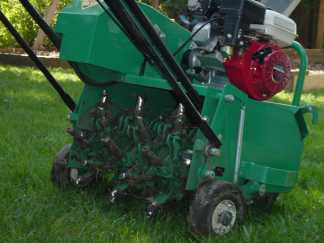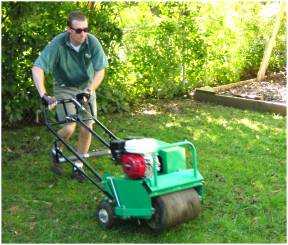
Turf Tips by Chris Karcher
Home
Current Issue
Previous
Issues
| the Savvygardener Community | |
| ~ | Gardening Forums, Blogs, Photos, Events and more... |
| Local Sponsors | |
| ~ | Family Tree Nursery |
| ~ | Missouri Organic Recycling |
| ~ | Ryan Lawn & Tree |
September
Turf Tips
Core Aeration & Care For Newly Seeded Lawns
To maintain a healthy lawn through periods of stress, the soil needs water, air and nutrients in the top 6 to 10 inches. Soils that are hard and compacted, have no "nooks and crannies" to hold the water, air or nutrients. Without these crucial components, root growth is impeded, which prevents the grass from developing the deep root system that is essential to survive in hot and dry or harsh and cold periods.
 |
| A core aerator's tines pull plugs of soil from the lawn. |
Core aeration is the process of mechanically removing plugs of thatch and soil from the lawn. Aeration opens the soil, helps reduce compaction, improves water infiltration, improves rooting, reduces thatch and acts in many other ways to improve the lawn and reduce stress. Aeration restores the vital "nooks and crannies" to the soil.
| Core aeration can be used to minimize thatch accumulation, to modify its physical characteristics, and to reduce soil compaction. Soil plugs are deposited on the turf surface (see right). These plugs then break down and redistribute soil throughout the thatch layer. The soil from the plugs helps to modify the physical structure of the thatch, making it a better growing medium. |  |
This soil also enhances thatch breakdown by introducing the beneficial microorganisms that feed on thatch.
|
|
Most turfgrasses growing in heavy clay or poor soils benefit greatly from annual aeration to reduce thatch buildup and more importantly, to relieve soil compaction. This cultural treatment will help improve the recycling flow of air, water, and fertilizer to your grass plants. This, in turn, will help to rejuvenate your grass by allowing the roots to grow deeper, creating healthier grass plants and keeping your lawn thicker and greener. |
Care For Newly Seeded Lawns
- Direct all traffic away from the seeded areas to avoid disturbing the seedbed.
- Core aerated lawns will have plugs of soil deposited across the surface of the lawn. These will break down readily over the next 10 to 14 days and need not be raked off.
- You must keep the seed moist. Daily watering for 15 -20 minutes per location until the seed germinates should be adequate. When the seedlings reach a height of 2 inches, watering may be adjusted to three times a week for 20 - 30 minutes per location.
- Do not mow areas until new seedlings are up about 3 inches. Use a sharp mower blade to prevent pulling seedlings out. If areas of the lawn become too tall, mow the areas at a 3 inch cutting height or higher.
- Do not panic if weeds come up in the seeded areas. These weeds can be controlled later after the new grass plants have been mowed twice.
- If leaves begin to mat areas down, they must be carefully removed. Preferably with a hand blower.
- Remember: Nature's way takes time! Depending on the type of seed, germination can be as short as seven days or as long as a month.
Do not get discouraged and forget to water. The best bluegrass seed usually takes between 21 - 28 days for germination and fescue from 10 - 20 days.
Chris Karcher is a local franchise owner of NaturaLawn of America - the leader in organic-based lawn care and the only national service provider to promote Environmentally Responsible lawn care. "Doing the right thing has never been this easy!"

© 1999 - 2009 Savvygardener.com, Inc. All rights reserved. If you wish to copy, transmit, or otherwise duplicate any of the material from our website please ask us first. Thank you.
